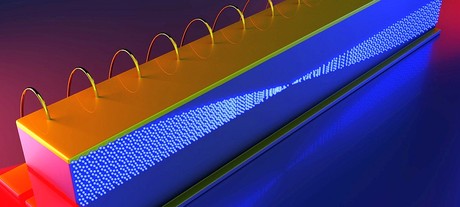Lasers may be the future of Wi-Fi

With Wi-Fi and cellular data traffic increasing exponentially and with bottlenecks approaching, many people hope that 5G will be the saviour of the situation. But even the early iterations of 5G won’t be able to handle the flood of data forever.
Shifting to terahertz frequencies could the answer, as signals at those frequencies could move hundreds of times more data than today’s wireless.
In 2017, researchers at the Harvard John A. Paulson School of Engineering and Applied Sciences (SEAS) discovered that an infrared ‘frequency comb’ in a quantum cascade laser could offer a new way to generate terahertz frequencies.
Now, the same researchers have uncovered a new phenomenon of quantum cascade laser frequency combs, which would enable these devices to act as integrated transmitters or receivers that can efficiently encode information.
“This work represents a complete paradigm shift for the way a laser can be operated,” said Federico Capasso, the Robert L. Wallace Professor of Applied Physics and Vinton Hayes Senior Research Fellow in Electrical Engineering and senior author of the paper.
“This new phenomenon transforms a laser — a device operating at optical frequencies — into an advanced modulator at microwave frequencies, which has a technological significance for efficient use of bandwidth in communication systems.”
Frequency combs are widely used, high-precision tools for measuring and detecting different frequencies of light. But this research wasn’t interested in the optical output of the laser.
“We were interested in what was going on inside the laser, in the laser’s electron skeleton,” said Marco Piccardo, a postdoctoral fellow at SEAS and first author of the paper. “We showed, for the first time, [that] a laser at optical wavelengths operates as a microwave device.”
The researchers discovered that light inside the cavity of the laser causes electrons to oscillate at microwave frequencies, and that these oscillations can be externally modulated to encode information onto a carrier signal.
“This functionality has never been demonstrated in a laser before,” said Piccardo. “We have shown that the laser can act as a so-called quadrature modulator, allowing two different pieces of information to be sent simultaneously through a single frequency channel and successively be retrieved at the other end of a communication link.”
“Currently, terahertz sources have serious limitations due to limited bandwidth,” said Capasso. “This discovery opens up an entirely new aspect of frequency combs and could lead, in the near future, to a terahertz source for wireless communications.”
The research, published in Optica, was supported by the US Defense Advanced Research Projects and the US National Science Foundation.
Please follow us and share on Twitter and Facebook. You can also subscribe for FREE to our weekly newsletter and bimonthly magazine.
Originally published here.
Why traditional transformation approaches fail field workers
A critical misstep in traditional transformation strategies is failing to understand the...
RFUANZ report: setting the frequency for success in 2025
Last year brought a lot of internal change for RFUANZ, but the association has hit the ground...
ARCIA update: an extended event calendar for 2025
With the addition of Tasmanian events and a conference in Adelaide in September, 2025 will see...





